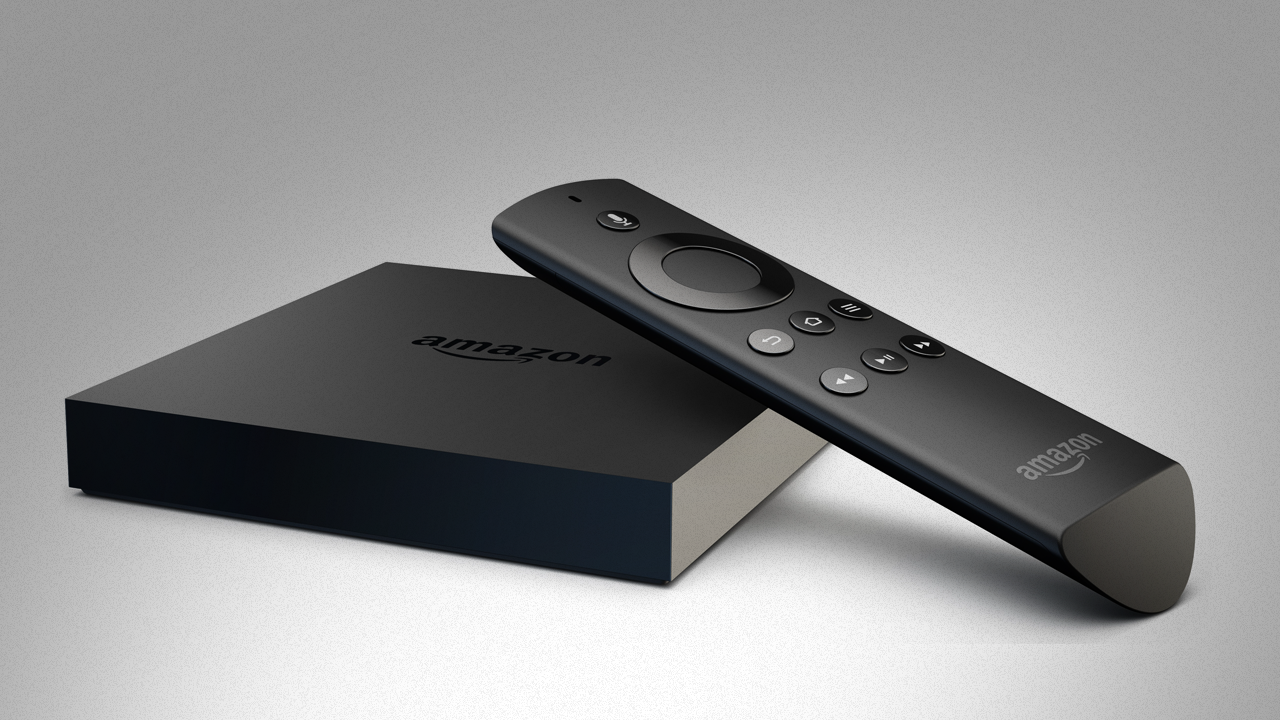TechRadar Verdict
Amazon's set-top box is elegant and powerful but not as open as it would like you to think.
Pros
- +
Powerful hardware
- +
Gorgeous design
- +
Voice search
Cons
- -
UI favors Amazon's offerings
- -
Lacks native local streaming
- -
Unrefined game controller
Why you can trust TechRadar
Updated: With its 5.2 update, Amazon has brought a whole host of improvements to the Fire TV. As well as improved parental controls, Amazon has also super-charged its Alexa integration. You can now launch apps using Alexa, as well as having the voice-assistant read you books from your Kindle library.
Original review below...
With the introduction of Fire TV, behemoth online retailer Amazon has entered the streaming set-top box battle that may ultimately determine the future of how we get content into our TVs. The device is competitive on both price and performance with Roku 3, Apple TV and Google Chromecast and seems squarely aimed at overthrowing those established players.
More competition has come along since its launch in 2014 (like the Nexus Player), but Amazon's stalwart box still holds one of the top two spots on our shelves. Why? The product, like Amazon itself, is friendly, powerful, and innovative and tackles some of the critical consumer complaints associated with the current streaming boxes.
Amazon explicitly stated that it wanted to address three problem areas about the consumer streaming experience: poor performance, closed ecosystems and cumbersome search.
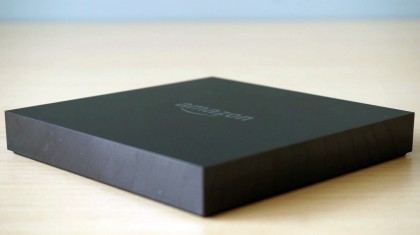
In terms of performance they have a clear winner on their hands. Fire TV is consistently snappy and responsive, thanks to some relatively beefy silicon inside.
It's a fairly open platform too (you'll find Netflix and HBO Go here), but its interface consistently tilts toward Amazon's offerings.
It can't access content from iTunes or Google Play (no surprise), but does support a wide array of third party services - including the highly coveted Sling TV app - and will presumably be adding more as time goes on. Third-party services, however, are relegated to second-class status within Fire TV's user interface. They sit in the system's "Apps" tab, while the system's prominent Movies, TV, Watchlist and My Library tabs all feed directly to Amazon's offerings.
The system's first-party offerings are always in plain view and accessible directly from the home screen. Third-party offerings tend to take some clicking and scrolling to get to.
While Amazon may overemphasize its own offerings, it's worth noting that the company has been putting serious work into beefing up its Amazon Prime Unlimited Streaming library. Along with a slate of well-produced original content, the company made a deal that will fold HBO's original programming (for shows more than 3 years old) into Prime Unlimited Streaming. They may not have Netflix's numbers yet, but Amazon is clearly becoming a serious player in the ongoing streaming services war.
In addition, Amazon recently launched its Prime Music service on the Fire TV that gives Amazon Prime users streaming access to an extensive library of top-tier music across a panoply of genres.
Other recent additions to the platform include Bluetooth headphone support, as well as expanded memory via USB - something users have been clamoring for since launch.
Search has been addressed with a slick voice recognition feature that uses a microphone on the remote to allow consumers to speak their searches instead of hunting and pecking across an on-screen letter grid. With access to cloud processing to handle the heavy lifting of voice recognition, the system does an excellent job of understanding what you're trying to tell it. However, voice searches only scan for Amazon and Vevo content, an unfortunate decision that significantly undercuts the utility of this breakthrough feature. Amazon has announced that it will be adding support for searching the catalogs of Hulu Plus, Crackle and Showtime Anytime. However, even with these additions, the device's tantalizing voice search function remains deeply underpowered.
Amazon has included some compelling extras, including the ability to view photos users have stored on Amazon Cloud Drive, and playback for Music purchased through its MP3 store. It's also put special focus on games with this system and thanks to a more powerful processor and Amazon's optional dedicated game controller ($40) Kindle Fire's gaming options surpass the Angry Birds-level options offered on similar devices. Still, most games are ports of existing Android titles that already run on the Kindle HDX, so while the games look and play well on the system, it doesn't have a patch on dedicated gaming consoles (which, to be fair, are typically far more expensive).
One potential differentiator for families is Amazon's integration of its FreeTime area, which allows parents to precisely proscribe the content kids access and their time on the system. It's an interesting offering that's not available on most other streaming boxes, however, it has its own set of drawbacks as well (see FreeTime section for further details).
Hardware and design
The box itself is about the size of a small external hard drive, or two CD jewel cases stacked on top of one another. Think of a tiny, squared-off version of the monolith from 2001: A Space Odyssey lying flat. Its exterior is sleek and minimalist, with the only contrast coming from glossy black lettering on a matte black background. At 0.7 inches thick, all of its visual cues seem to be telling you, "Don't see me." Its rear side is devoted to the essential ports: power, HDMI, optical audio, Ethernet and USB.
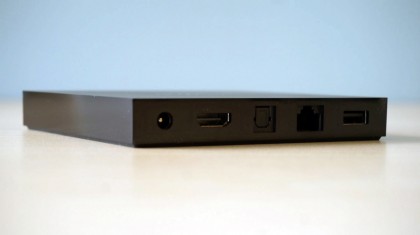
Under the hood, Fire TV is quite powerful compared to its competitors, sporting a quad-core processor, a discrete GPU and 2GB of RAM. Amazon claims it has three times the processing power of Apple TV, Chromecast or Roku 3, and says it can process 57 billion floating point operations per second. You can wire it into your router via Ethernet, but if that's inconvenient, Fire TV also packs two dual-band Wi-Fi antennas. All of this adds up to notably snappy menu performance. Movie titles fly by in the interface, transitioning between services is fast and the system handles itself well when tasked with rendering games.
The Fire TV's minimalist matte black remote is similar in functionality to Roku's, with seven glossy black buttons and a directional selector. It uses Bluetooth to communicate, eliminating line-of sight issues and allowing you to stash the box inside a cabinet or behind a TV. There are buttons for back, home, menu, rewind play/pause and fast forward. Topping the remote on its own is the microphone button that may one day be Fire TV's secret weapon (but not now, for more on this see the Interface and Search section).
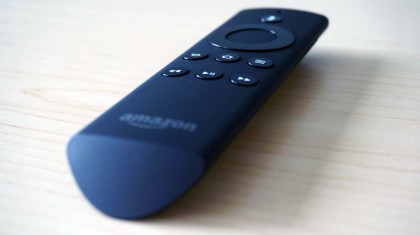
Setup
As with Roku 3 and Apple TV, Fire TV's setup is eerily simple, and consists of connecting two or three wires (power, HDMI and an optional ethernet cable). If you don't have it wired to your router, the system will walk you through forging a WiFi connection. As with the Kindle Fire, when you order a Fire TV, Amazon pre-links it to your Amazon account, so after a quick (unskippable) tutorial video you're immediately able to browse Amazon Instant and Amazon Prime videos along with any photos in your cloud drive. Third party apps must be downloaded and set up separately with their own credentials. In terms of simplicity, the setup process is a win, but its lack of customization options leaves you at the mercy of the one-size-fits-all menu hierarchy Amazon has created (more on this later).
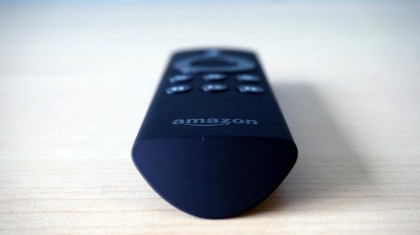
Movies and TV
Naturally, the system provides full-spectrum access to Amazon's cloud video services, and Amazon Instant and Amazon Prime Video are both well (if not over) represented. At launch, Fire TV offered 40 third-party channels, a far cry from the hundreds available on Roku and Chromecast, but more are slowly-but-surely trickling in. Predictably however, iTunes and Google Play are not available on the system, nor are they likely to be.
Amazon is touting Fire TV's innards as a competitive advantage in terms of movie performance, but while menus move quickly, our tests didn't uncover much difference in terms of speed to open third party apps or start playing videos as compared with Roku 3 or AppleTV.
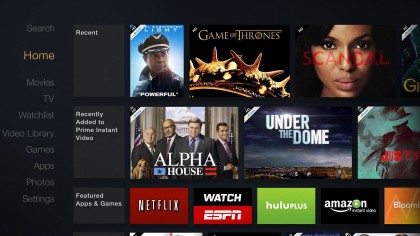
Amazon's native offerings, on the other hand, clearly get a boost from living on their home hardware. First off, all of Amazon's content is accessible from the main menu of the system's OS and can start playing without first launching an app. Secondly, Amazon is introducing a feature called ASAP, which is designed to pre-cache video content for you based on your habits and preferences. I saw this in action when I watched the 11th episode of Alpha House (I had previously watched the first 10 episodes, but not on the Fire TV). Impressively, playback began instantaneously when I clicked, with no load time or buffering. Supposedly the system will make more inferences over time as it monitors my actions. It's a smart, effective system, but as only Amazon's offerings can use it, it's one more way the playing field inside Fire TV is tilted to the home team's advantage.
Music, photos and gaming
Amazon's added a music channel post-launch that allows consumers to access any music stored in their cloud drive (all MP3s bought through Amazon are stored in your Cloud Drive for free), as well as support for its Prime Music service, which offers access to a large library of quality music tracks organized into curated playlists. Fire TV also supports third party music services such as iHeartRadio, Pandora, Spotify, TuneIn and, most recently, Rdio.
The photo channel provides a way to access any photos or videos you have stored in Amazon Cloud Drive. Amazon provides a free 5GB of storage for all accounts, and more can be purchased via subscription. The system works simply and seamlessly. You can upload photos from your computer, or use Amazon's iOS or Android apps to automatically put any photos you take up on the cloud. In addition to letting you page through slide shows, Fire TV can be set to use your images as a screensaver when the system is idle.
It's clear Amazon sees games as a key piece of their strategy with this box. The idea here seems to be to capture casual gamers who aren't sufficiently invested to buy a $400 to $500 dedicated games console, not a bad bet in a time when mobile gaming is reaching more consumers than ever. Since Fire TV runs the latest version of Amazon's Fire OS ("Mojito"), which is based on Android, it's relatively easy for existing Android games to be ported to work on the system and developers I spoke with from Telltale Games (The Walking Dead) and Mojang (Minecraft) both emphasized how easy it was to move their games onto the platform from their existing games, both of which already run on the Kindle Fire HDX.
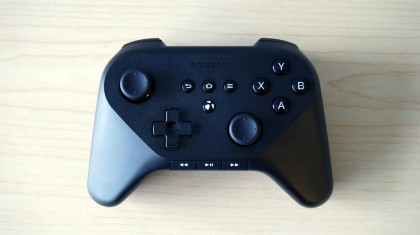
Amazon's seriousness about gaming is best exemplified by its creation of a dedicated game controller for the system (sold separately, $40). While serviceable, the controller doesn't show the same polish as the rest of the system. Looking like a cross between an Xbox 360 controller and the Ouya controller, the feel of the face buttons and sticks is solid, but its shoulder buttons are a bit stiff and the triggers have a shallow travel that feels unsatisfying. It's worth noting that many of the games on the system (primarily those with simple tablet-type controls) are playable with only the remote.
Standout titles include Minecraft, The Walking Dead Seasons 1 and 2, Telltale's Game of Thrones, Terraria, Zen Pinball, You Don't Know Jack, Crossy Road, Grand Theft Auto: San Andreas and the original Sonic The Hedgehog games.

The controller also sports all the buttons on the remote (including play/pause, fwd and rew), allowing you to easily manipulate the system's media options via the controller.
But the newest and most impressive capability of the box and its gamepad is the ability to stream games via GameFly's Fire TV-exclusive app. The app itself is free to download and currently supports 36 titles ranging from triple-A titles like Batman: Arkham City, Sleeping Dogs, Hitman: Absolution and Darksiders 2 to lesser known titles like Giana Sisters: Twisted Dreams and Blaz Blue: Continuum.
The app streams at a solid 720p resolution and hovers around 30 frames per second. It firmly requires a wired ethernet connection however, and can't be used over Wi-Fi.
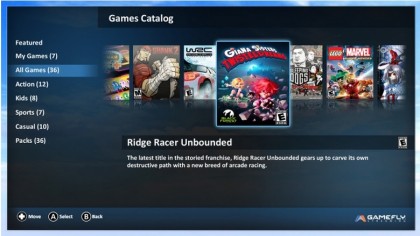
Overall performance was solid, but couldn't quite rival that of PlayStation Now or Nvidia Grid, the latter of which is free to owners of the competing Nvidia Shield Android TV set-top box. At around $10 for one month's access to 16 titles, the pricing is fair but might provide just enough of a barrier to entry to stop some users from investing in the service.
Interface and search
Amazon has built an amazingly elegant solution to search in this device, thanks to a microphone embedded in the remote and cloud-powered voice recognition. Unfortunately, the way they have implemented this breakthrough feature is deeply anti-consumer. Voice recognition is accurate and solves the aggravating problem of tapping in your searches in via an on-screen letter grid. However, Amazon has destroyed most of the value of searching this way as voice searches scan only Amazon's native content library.
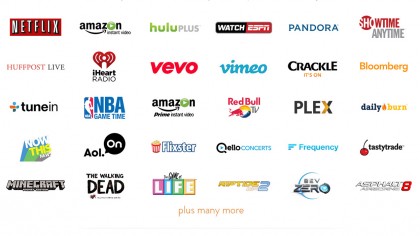
This search myopia isn't only limited to the voice feature though. Indeed there is currently no way to search across services on the device. When I search Roku for a film it tells me if it's on Netflix, Crackle and others as well as if it's on Amazon. I ran into several scenarios where I searched for content I know is on another service (that I'm already paying for) and was only presented the option of buying or renting it from Amazon. It's the device's most serious flaw and Amazon should address if they want their device to be as consumer-friendly as they claim.
Amazon's self-bias is even more striking in the menu structure it has created. Of the 10 top-level tabs on its home screen (Search, Home, Movies, TV, Watchlist, Video Library, Games, Apps, Photos, Settings), all but three (Home, Games and Apps) are for Amazon services. Third party apps are relegated to the "Apps" tab. Thus, four of the highest-level menu items are devoted to different aspects of Amazon's video services, while a single menu item at the bottom of the page houses 40-plus third party apps. Certain high-profile apps (Netflix, Hulu) are profiled on the Home tab under Featured Apps and Games (which sits just below the "Recently Added To Prime" area). To make matters worse, the Apps tab is populated by games as well as apps (the Games tab only has games in it), making that area even more cluttered than it has to be.
In short, Amazon seems to be going out of its way to bury third-party apps on the system. It's not a dealbreaker, as most consumers will be aware of the services they want on their device and figure out how to find them, but it's irksome that these services require several extra clicks to access and can't be customized. Tip: Voice search can be used to navigate to apps you have installed and is often the fastest and easiest way to find a given app.
Freetime
FreeTime, FireTV's most ironically named feature, is there to make 100% sure your children are not free to watch whatever they would like. In addition, the service costs $5 per month, making it the opposite of both meanings of the word "free" (though Amazon does offer a 1-month free trial of the service).
The idea behind FreeTime is a solid one. We're sure many parents would appreciate the peace of mind that comes with knowing that your children are only accessing content from trusted and age-appropriate sources. In practice, however, FreeTime has a long way to go before we can recommend paying extra money to access it (let alone recommend it as a reason to buy the system).
The service operates by having parents create profiles for each child in the household, then white-list specific apps and video content they want that child to have access to. In addition, the system lets parents specify how much time each child is allowed to spend on the system per day in increments of 15 minutes, as well as blocking off certain times. For example, I could allow one child an hour of FireTV time between 4pm and 8pm. And if I were feeling especially mean, I could allow another child four hours of screen time, but only between 2am and 6am. Parents can also set whether a child's time spent on apps, video or either.
The primary flaw in the system is its selection of video content. Currently FreeTime only allows parents to white-list individual videos that has been either purchased from Amazon or are available via Amazon Prime Instant Video. Netflix and other apps are available, but if you give your kid access, they can see every movie on that service (meaning that adding them to your child's library undermines the entire point of FreeTime). Given how open FireTV's ecosystem is and how much wonderful children's content is available on Hulu Plus, Netflix and others, it feels ridiculous (and possibly manipulative) to allow parent's to only proscribe choices that only come from Amazon's libraries.
In addition, FreeTime must be activated for it to work. Once the system is signed into FreeTime mode for a given kid, the countdown timer starts and it's impossible to exit to the main menu without entering a PIN. However, if an unsupervised kid is tech-savvy enough to get the system turned on by themselves (and newsflash, most are) they'll have full access to everything until FreeTime is activated. Also, when the PIN is entered (as it must be to change content choices), the magic numbers are plainly visible on screen, not even obscured by asterisks. And this is all assuming that the FireTV is the only source of content connected to the TV. The idea of this being a serious impediment to any media-hungry kid over age six is a little absurd.
The idea behind FreeTime is sound, but in its current half-executed form, it's largely useless, primarily due to its lack of hooks into the other video apps on the system. FreeTime is not yet a compelling reason to buy FireTV, even for those with small children they want to safely park in front of the flatscreen. Thankfully for FireTV, FreeTime is not its only trick and the box is compelling enough on its other merits to justify purchase. We hope to see Amazon work to improve this feature down the road.
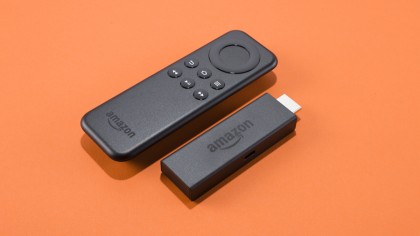
Amazon Fire TV vs the Amazon Fire TV Stick
The Amazon Fire TV Stick packs everything we love about the full-size box into a petite, powerful form factor. For better or worse the interfaces are identical and lean heavily on Prime content.
The big differences between the two streamers are the remotes (the Stick's stick doesn't have a built-in mic), and the silicon inside the machines. By and large the Amazon Fire TV proper has better internals and therefore can play games like the gorgeously addicting Crossy Road and Zen Pinball without a problem. The Amazon Fire TV Stick has gaming capabilities too, however, you're more apt to find Solitaire and Threes than you are anything more complex.
If you're just looking for a streamer and don't mind a bit more lag time when starting a show or film, then save yourself some cash and check out the pint-sized stick instead.
